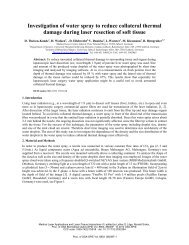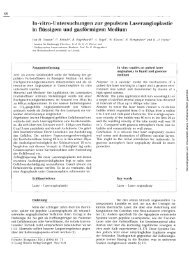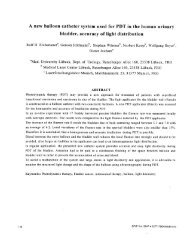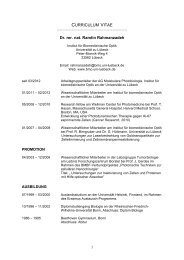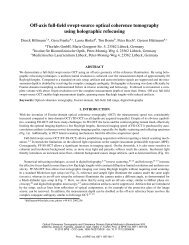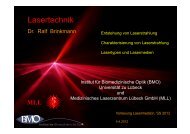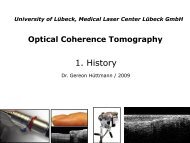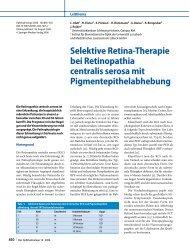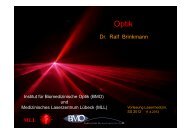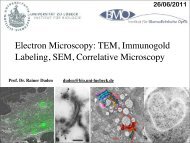Invited p aper Mechanisms of femtosecond laser nanosurgery of ...
Invited p aper Mechanisms of femtosecond laser nanosurgery of ...
Invited p aper Mechanisms of femtosecond laser nanosurgery of ...
You also want an ePaper? Increase the reach of your titles
YUMPU automatically turns print PDFs into web optimized ePapers that Google loves.
VOGEL et al. <strong>Mechanisms</strong> <strong>of</strong> <strong>femtosecond</strong> <strong>laser</strong> <strong>nanosurgery</strong> <strong>of</strong> cells and tissues 1031as the starting nucleus for the cavitation bubble. The heatedand stretched material within the nucleus commences to expandinstantaneously (within less than 1ps) once the kineticspinodal is reached [168]. As driving force for the expansiononly the negative part <strong>of</strong> the time-dependent stress in thecenter <strong>of</strong> the focal volume was considered, because the nucleusdoes not exist before the tensile stress arrives. This isin contrast to simulations <strong>of</strong> heterogeneous cavitation wherepre-existing gas bubbles interact with a time-varying pressurewave [158]. Only cases were simulated in which the temperaturein the center <strong>of</strong> the focal volume slightly exceeds thephase-transition threshold and the size <strong>of</strong> the resulting nucleusis small compared with the focal volume. This justifies usingthe tensile stress amplitude in the center <strong>of</strong> the undisturbedfocal volume as driving force for the bubble expansion. Forlarger <strong>laser</strong> pulse energies one would need to consider that thetensile stress is diminished by the rupture <strong>of</strong> the liquid.After the passage <strong>of</strong> the tensile stress transient, the vaporpressure p v inside the bubble continues to drive the bubble expansion.The initial vapor pressure is calculated for a temperatureaveraged over all volume elements within the nucleus.During bubble growth, it will drop due to the cooling <strong>of</strong> the expandingbubble content. This cooling is counteracted by heatdiffusion from the liquid surrounding the bubble. The temperature<strong>of</strong> this liquid, on the other hand, drops because <strong>of</strong> heatdiffusion out <strong>of</strong> the focal volume as depicted by the dashedlines in Fig. 10. To quantify the temporal evolution <strong>of</strong> the drivingpressure, we consider two limiting cases:Case 1: Bubble size ≪ focal volume. We assume that thebubble initially expands adiabatically until the average temperature<strong>of</strong> the bubble content has fallen to the temperature<strong>of</strong> the liquid at the nucleus wall. Afterwards, heat flow fromthe surrounding liquid maintains the temperature <strong>of</strong> the bubblecontent at the same level as that <strong>of</strong> the surrounding liquid.The bubble pressure p v (t) thus equals the equilibrium vaporpressure corresponding to the temperature at the nucleus wall,which, for NA = 1.3, decays within about 20 ns to 1/e <strong>of</strong> itsinitial value (Fig. 10a). Justifications for this hypothesis arethe small bubble size and the fact that the bubble nucleus is notempty but contains material that is initially at liquid densityand has a relatively large heat capacity.Case 2: Bubble size comparable to or larger than the focalvolume. When the size <strong>of</strong> the nucleus becomes comparable tothe size <strong>of</strong> the focal volume, the bubble expands more rapidly.In this case, the heated liquid shell surrounding the bubble israpidly thinned, which leads to an accelerated heat dissipationinto adjacent liquid. The heat flow into the bubble is probablysmall compared with the amount <strong>of</strong> heat contained in the materialwithin the bubble nucleus. Therefore, the entire bubbledynamics is modeled as an adiabatic expansion. As a consequence,the vapor pressure drops much faster than in case 1.In both cases, the ongoing phase transition in the bubble wasneglected to obtain tractable expressions for p v (t).Thissimplificationenabled us to use the Gilmore model to describe thebubble dynamics [158, 169, 170]. The pressure drop is in case1 slower and in case 2 faster than the pressure decay correspondingto the actual phase transitions <strong>of</strong> the bubble content.Therefore, these cases represent upper and lower limits for theevolution <strong>of</strong> the actual bubble size after <strong>femtosecond</strong> opticalbreakdown.6.2 Evolution <strong>of</strong> the stress distributionThe thermalization time <strong>of</strong> the energy carried bythe free electrons was assumed to be 10 ps. ForNA = 1.3,λ = 800 nm, and a sound velocity in water <strong>of</strong> c 0 = 1500 m/s,the acoustic transit time to the periphery <strong>of</strong> the heated regionwith 168-nm radius is 112 ps. Thus, the dimensionlessthermalization time (thermalization time divided byacoustic relaxation time) is tp ∗ = 0.09, which correspondsto a very high degree <strong>of</strong> stress confinement. The ‘thermalizationpulse’ was assumed to have a Gaussian temporalshape, with the peak at t = 0. By comparison with anexponential thermalization pulse we found that, for shortdimensionless pulse durations tp ∗ , the pulse shape has littleinfluence on the shape and amplitude <strong>of</strong> the stresswave.Figure 14 shows the spatial stress distribution in radial andaxial directions for various points in time after the release <strong>of</strong>the <strong>laser</strong> pulse, and Fig. 15 presents the temporal evolution <strong>of</strong>the stress amplitude in the center <strong>of</strong> the focal volume. All pressureamplitudes are normalized to the peak compressive stresscreated in the focal volume.FIGURE 14 Stress distribution produced by a single <strong>femtosecond</strong> pulse <strong>of</strong>800-nm wavelength focused into water (NA = 1.3), for various times afterthe release <strong>of</strong> the <strong>laser</strong> pulse; (a) in radial direction, (b) in axial direction. Thethermalization time <strong>of</strong> the energy carried by the free electrons was assumedto be 10 ps. The dimensionless thermalization time (thermalization time dividedby acoustic relaxation time) was tp ∗ = 0.09. The ‘thermalization pulse’was assumed to have a Gaussian temporal shape, with the peak at t = 0. Thepressure amplitudes are normalized to the peak compressive stress created inthe focal volume



